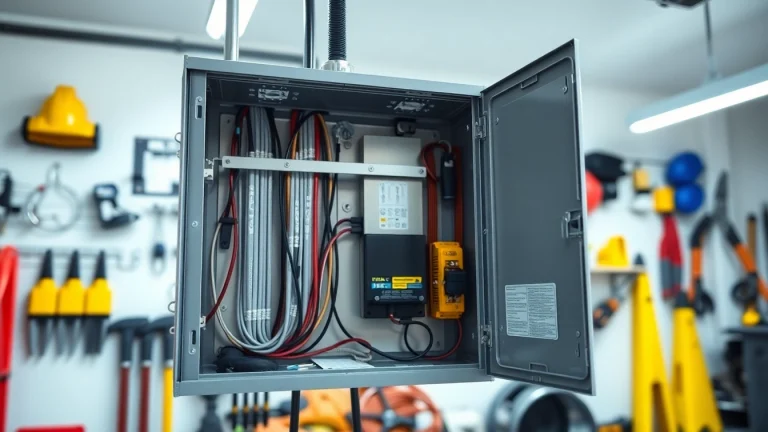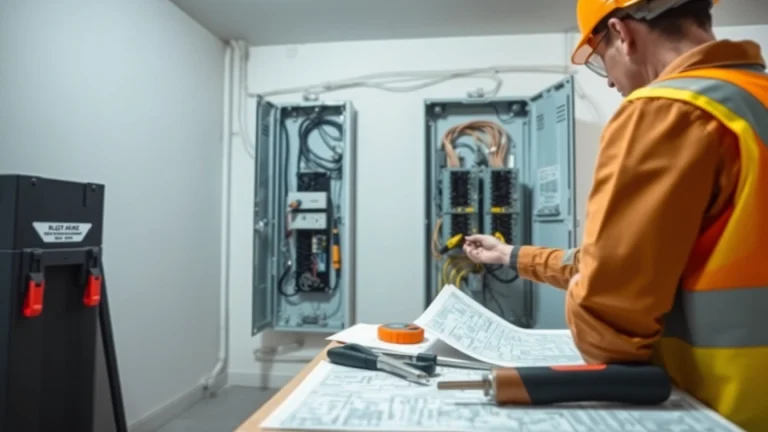
Why an Electrical Panel Upgrade is Essential for Modern Homes
Understanding the Need for Electrical Panel Upgrade
Upgrading your electrical panel is a crucial consideration for any homeowner. As technology evolves and energy demands increase, understanding when and why to upgrade an electrical panel becomes imperative for both safety and efficiency. This article serves as a comprehensive guide that covers the essentials of electrical panel upgrades, the indicators that suggest it’s time for one, and the numerous benefits associated with this critical home improvement.
What Is an Electrical Panel?
An electrical panel, also known as a breaker panel or service panel, is the hub of your home’s electrical system. It distributes electricity from the utility service into the various circuits throughout your home and is responsible for controlling voltage and ensuring safety by disconnecting power when a circuit is overloaded. Typically located in basements, garages, or utility rooms, the electrical panel consists of a main switch, circuit breakers, and wiring that connects to the electrical grid.
Signs That Your Electrical Panel Needs an Upgrade
There are several telltale signs that your electrical panel may need an upgrade:
- Frequent Circuit Breaker Trips: If your circuit breakers trip frequently, it indicates that your current panel may not handle your energy demands efficiently.
- Flickering Lights: Flickering or dimming lights can be a symptom of overloading or faulty wiring from an outdated panel.
- Burning Smells: Smelling burning plastic or seeing signs of scorching near your panel can signal dangerous malfunctioning.
- Older Panel Models: If your panel is more than 30 years old, it may not meet modern safety standards or support your home’s electrical needs.
- Inadequate Amperage: Homes today often require more power. If your panel is under 100 amps, it might necessitate an upgrade.
Benefits of an Electrical Panel Upgrade
Upgrading your electrical panel can deliver a range of benefits:
- Increased Electrical Capacity: A modern panel often supports a higher amperage, allowing for more devices and appliances to be used without risking overloads.
- Improved Safety: Newer panels comply with current safety codes and reduce the risk of electrical hazards, such as shocks or fires.
- Energy Efficiency: Upgraded panels can better manage your energy load, reducing energy waste and possibly lowering utility bills.
- Future-Proofing: As our reliance on technology grows, a new panel can prepare your home for upcoming electrical needs, such as electric vehicle chargers and high-efficiency appliances.
- Enhanced Home Value: Having a modern electrical system can be a significant selling point for prospective buyers.
Assessing Your Current Electrical Capacity
Before deciding to upgrade, it’s essential to assess your current electrical capacity comprehensively. This section dives into the methods of understanding your present setup and what improvements you might need.
Measuring Amperage: What You Need to Know
Your electrical panel’s amperage rating indicates its capacity to handle electrical loads. Most homes have panels rated between 100 amps and 200 amps. To check your panel’s amperage:
- Open your electrical panel. Ensure safety while doing this.
- Locate the labeling, which indicates the total amperage (look for a number like 100, 150, or 200).
- If there is no visible label, consult with a licensed electrician for precise measurements and assessments.
If you frequently run multiple high-wattage appliances (like dryers, ovens, and HVAC systems) simultaneously, a 200-amp panel may be a necessity.
Evaluating Circuit Breaker Configuration
Take note of how your circuits are arranged. A properly configured panel will ensure that load distribution is even across circuits. Signs of poor configuration include:
- Circuit breakers that are constantly overloaded or tripped.
- A panel that is fully populated with little room for expansion.
- Circuit breakers that fail to reset or operate erratically.
If any unusual patterns arise, it may be time for an upgrade or reconfiguration.
Common Issues with Aging Electrical Panels
Aging electrical panels are susceptible to several issues that can compromise safety and efficiency:
- Corrosion and Rust: Older panels might develop rust, affecting electrical connections and safety.
- Worn Out Breakers: Circuit breakers may weaken over time, leading to potential electrical fires.
- Insufficient Breaker Space: Older models often come with limited room to add new circuits, necessitating an upgrade as technology progresses.
Typical Costs Associated with Electrical Panel Upgrade
Understanding the financial commitment necessary for an electrical panel upgrade can help you plan effectively. In this section, we’ll explore typical costs, variables affecting pricing, and comparisons between different upgrade types.
Cost Breakdown: Labor and Materials
The total cost of upgrading an electrical panel can range significantly based on various factors, but you can expect the following breakdown:
- Labor Costs: Electricians typically charge between $50 and $120 per hour. Depending on complexity, labor may range from 4 to 10 hours for an upgrade.
- Materials Costs: The electrical panel itself may cost between $100 and $600. Additional materials, such as wiring, breakers, and connectors, can range from $100 to $1,000 depending on your unique situation.
- Additional Fees: Depending on your location and specific situation, permits and inspection fees may add to your overall cost.
Factors Influencing Upgrade Costs
Several key factors influence the overall cost of an electrical panel upgrade:
- Panel Size: Upgrading from 100 amps to 200 amps will generally cost more in both materials and labor.
- Region: Labor rates vary by geographic area, affecting total costs.
- Current Condition: If significant repairs or rewiring are necessary, costs can skyrocket.
- Accessibility: Panels that are difficult to access or in cramped spaces may require additional labor costs.
Cost Comparisons: 100A vs. 200A Upgrade
When considering an upgrade, it’s essential to evaluate whether a 100A to 200A transition is worth the investment:
- 100A Upgrade: This option typically serves smaller homes or apartments and can cost between $800 and $2,500. However, it may not accommodate future needs as energy consumption grows.
- 200A Upgrade: More suitable for larger homes or those with additional energy demands, this upgrade usually costs between $1,500 and $4,500. Although pricier, it offers added capacity and resilience against future energy needs.
Choosing the Right Upgrades for Your Home
Choosing the right upgrades is paramount to ensuring your electrical system meets current and future demands. This section discusses various considerations for optimal upgrades.
Assessing Future Electrical Needs
Before upgrading, consider how your electrical usage may change in the future. Trends in technology usage include:
- The rise of smart home devices.
- Increased use of electric vehicles.
- Higher electrical consumption from modern appliances.
Consider consulting with an electrician knowledgeable about current trends to gauge future needs accurately.
Choosing Energy-Efficient Panels
Upgrading to energy-efficient panels not only improves performance but can also lead to long-term savings:
- Smart Panels: These panels offer monitoring features that help gauge energy usage and avoid overloads.
- Panel with Surge Protection: An energy-efficient panel that includes surge protection safeguards sensitive electronics from spikes in electricity.
- Environmental Considerations: Choosing panels that are energy-rated can qualify you for energy savings programs or tax credits.
The Importance of Working with Licensed Electricians
Even if you’re inclined to take on DIY projects, upgrading your electrical panel is not one of them. Here are some reasons why you should engage a licensed electrician:
- Expertise: Licensed electricians have the skills and knowledge to navigate complex electrical systems safely.
- Compliance: They ensure that all work complies with local building codes, minimizing the risk of fines or issues at resale.
- Quality Assurance: A professional guarantees that the job is done right the first time, reducing the likelihood of future problems.
Safety Standards and Regulatory Compliance
Safety is paramount when dealing with electrical systems. This section delves into understanding safety standards and ensuring compliance during your upgrade.
Understanding Electrical Codes and Permits
Electrical codes vary by location but generally govern how electrical systems should be designed and maintained. Obtaining the required permits is essential, as local authorities will need to inspect the work before it can be deemed compliant. Avoid working without proper permits to prevent legal issues and potential fines.
How to Ensure Compliance During Upgrades
During the upgrade process, ensure compliance by:
- Working with a licensed electrician who is familiar with local codes.
- Submitting all required applications to local authorities prior to the work
- Documenting all work completed for future reference, including photographs and permits.
Post-Upgrade Inspections and Follow-up
After the upgrade is complete, it’s wise to have a follow-up inspection performed by local code enforcement to ensure everything is compliant. This can also help catch any potential issues early on. Regular maintenance checks can keep your electrical system running smoothly.
In conclusion, upgrading an electrical panel is essential for maintaining a safe and efficient home. The need for higher capacity, safety considerations, and the increasing reliance on technology underscore the importance of staying current with your electrical system. Whether you are experiencing signs that an upgrade is necessary or simply wish to future-proof your home, understanding the process, costs, and benefits allows for informed decision-making.


